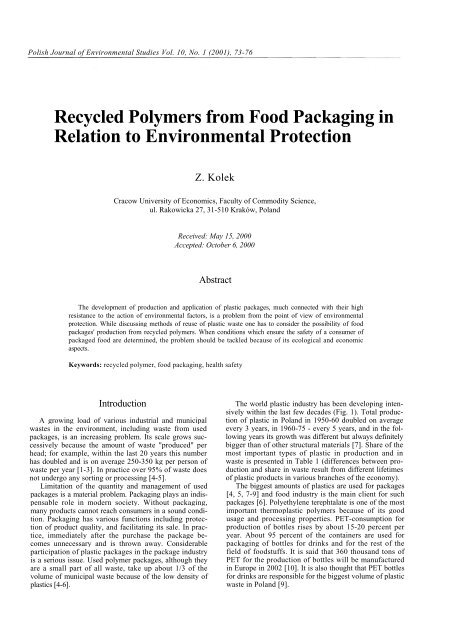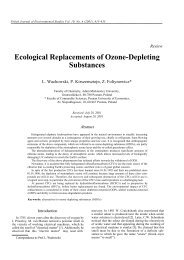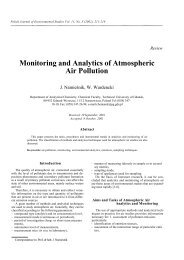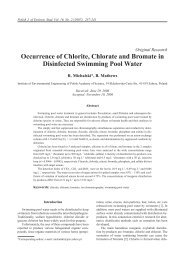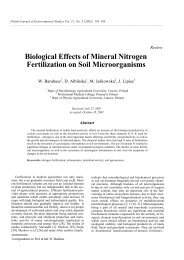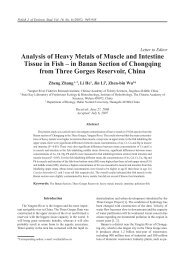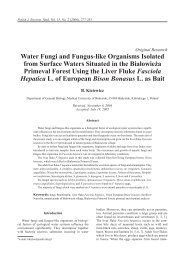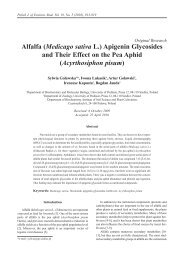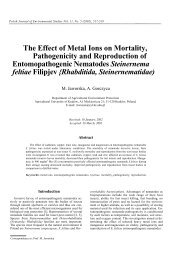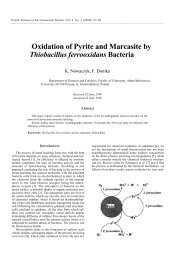Recycled Polymers from Food Packaging in Relation to ...
Recycled Polymers from Food Packaging in Relation to ...
Recycled Polymers from Food Packaging in Relation to ...
You also want an ePaper? Increase the reach of your titles
YUMPU automatically turns print PDFs into web optimized ePapers that Google loves.
Polish Journal of Environmental Studies Vol. 10, No. 1 (2001), 73-76<br />
<strong>Recycled</strong> <strong>Polymers</strong> <strong>from</strong> <strong>Food</strong> <strong>Packag<strong>in</strong>g</strong> <strong>in</strong><br />
<strong>Relation</strong> <strong>to</strong> Environmental Protection<br />
Z. Kolek<br />
Cracow University of Economics, Faculty of Commodity Science,<br />
ul. Rakowicka 27, 31-510 Kraków, Poland<br />
Received: May 15, 2000<br />
Accepted: Oc<strong>to</strong>ber 6, 2000<br />
Abstract<br />
The development of production and application of plastic packages, much connected with their high<br />
resistance <strong>to</strong> the action of environmental fac<strong>to</strong>rs, is a problem <strong>from</strong> the po<strong>in</strong>t of view of environmental<br />
protection. While discuss<strong>in</strong>g methods of reuse of plastic waste one has <strong>to</strong> consider the possibility of food<br />
packages' production <strong>from</strong> recycled polymers. When conditions which ensure the safety of a consumer of<br />
packaged food are determ<strong>in</strong>ed, the problem should be tackled because of its ecological and economic<br />
aspects.<br />
Keywords: recycled polymer, food packag<strong>in</strong>g, health safety<br />
Introduction<br />
A grow<strong>in</strong>g load of various <strong>in</strong>dustrial and municipal<br />
wastes <strong>in</strong> the environment, <strong>in</strong>clud<strong>in</strong>g waste <strong>from</strong> used<br />
packages, is an <strong>in</strong>creas<strong>in</strong>g problem. Its scale grows successively<br />
because the amount of waste "produced" per<br />
head; for example, with<strong>in</strong> the last 20 years this number<br />
has doubled and is on average 250-350 kg per person of<br />
waste per year [1-3]. In practice over 95% of waste does<br />
not undergo any sort<strong>in</strong>g or process<strong>in</strong>g [4-5].<br />
Limitation of the quantity and management of used<br />
packages is a material problem. <strong>Packag<strong>in</strong>g</strong> plays an <strong>in</strong>dispensable<br />
role <strong>in</strong> modern society. Without packag<strong>in</strong>g,<br />
many products cannot reach consumers <strong>in</strong> a sound condition.<br />
<strong>Packag<strong>in</strong>g</strong> has various functions <strong>in</strong>clud<strong>in</strong>g protection<br />
of product quality, and facilitat<strong>in</strong>g its sale. In practice,<br />
immediately after the purchase the package becomes<br />
unnecessary and is thrown away. Considerable<br />
participation of plastic packages <strong>in</strong> the package <strong>in</strong>dustry<br />
is a serious issue. Used polymer packages, although they<br />
are a small part of all waste, take up about 1/3 of the<br />
volume of municipal waste because of the low density of<br />
plastics [4-6].<br />
The world plastic <strong>in</strong>dustry has been develop<strong>in</strong>g <strong>in</strong>tensively<br />
with<strong>in</strong> the last few decades (Fig. 1). Total production<br />
of plastic <strong>in</strong> Poland <strong>in</strong> 1950-60 doubled on average<br />
every 3 years, <strong>in</strong> 1960-75 - every 5 years, and <strong>in</strong> the follow<strong>in</strong>g<br />
years its growth was different but always def<strong>in</strong>itely<br />
bigger than of other structural materials [7]. Share of the<br />
most important types of plastic <strong>in</strong> production and <strong>in</strong><br />
waste is presented <strong>in</strong> Table 1 (differences between production<br />
and share <strong>in</strong> waste result <strong>from</strong> different lifetimes<br />
of plastic products <strong>in</strong> various branches of the economy).<br />
The biggest amounts of plastics are used for packages<br />
[4, 5, 7-9] and food <strong>in</strong>dustry is the ma<strong>in</strong> client for such<br />
packages [6]. Polyethylene terephtalate is one of the most<br />
important thermoplastic polymers because of its good<br />
usage and process<strong>in</strong>g properties. PET-consumption for<br />
production of bottles rises by about 15-20 percent per<br />
year. About 95 percent of the conta<strong>in</strong>ers are used for<br />
packag<strong>in</strong>g of bottles for dr<strong>in</strong>ks and for the rest of the<br />
field of foodstuffs. It is said that 360 thousand <strong>to</strong>ns of<br />
PET for the production of bottles will be manufactured<br />
<strong>in</strong> Europe <strong>in</strong> 2002 [10]. It is also thought that PET bottles<br />
for dr<strong>in</strong>ks are responsible for the biggest volume of plastic<br />
waste <strong>in</strong> Poland [9].
74<br />
Kolek Z.<br />
Table 2 Packages <strong>in</strong>troduced <strong>to</strong> the Polish market accord<strong>in</strong>g <strong>to</strong> the<br />
type of material (<strong>in</strong> thousands of <strong>to</strong>ns) [11].<br />
Fig. 1. The 1960-1997 and the 2050 (prognosis) productions of<br />
plastics <strong>in</strong> the world (<strong>in</strong> millions of <strong>to</strong>ns) [7].<br />
Table 1 Share of most important types of plastics <strong>in</strong> production<br />
and waste [4, 5].<br />
Ecological Problems Related <strong>to</strong> Packages<br />
Ecological danger <strong>from</strong> packages is related <strong>to</strong> the fact<br />
that the amount of produced and used packages grows<br />
quickly. General data show that world production of<br />
packages is on the level of about 1500 millions <strong>to</strong>ns per<br />
year [6]. Usage of various k<strong>in</strong>ds of package materials <strong>in</strong><br />
Poland is shown <strong>in</strong> Table 2.<br />
Recovery of particular types of packages differs and is<br />
estimated as [11]:<br />
plastics 1.5%,<br />
metals 5.3%,<br />
glass 9.4%,<br />
paper and cardboard 35%.<br />
Packages are a source of environmental pollution with<br />
various substances: metals, plastics, glass, paper, cardboard<br />
and other materials. Some of these materials come<br />
<strong>from</strong> renewable natural resources; others are non-renewable.<br />
This division, important <strong>from</strong> ecological and economical<br />
po<strong>in</strong>ts of view, makes the presentation of ecological<br />
dangers easier through a study of ecological balances.<br />
Package waste management should be based on the<br />
rules which result <strong>from</strong> Directive 94/62/EC [12]. The follow<strong>in</strong>g<br />
types of activities are goals of environmental protection:<br />
- Limitation of the number, cubature, material and en<br />
ergy consumption of packages used,<br />
- Aim<strong>in</strong>g at reuse of packag<strong>in</strong>g,<br />
- Process<strong>in</strong>g of packag<strong>in</strong>g waste,<br />
- Liquidation through <strong>in</strong>c<strong>in</strong>eration or compost<strong>in</strong>g of<br />
packag<strong>in</strong>g waste,<br />
- Organised s<strong>to</strong>rage.<br />
Used packag<strong>in</strong>g could be divided <strong>in</strong><strong>to</strong> [13]:<br />
- Troublesome for the environment (packag<strong>in</strong>g for foods<br />
and some pharmaceutics),<br />
- Harmful for the environment (packag<strong>in</strong>g for some<br />
chemicals and plant protection chemicals* and for<br />
some pharmaceutics),<br />
- Harmful and burdensome <strong>to</strong> people (packag<strong>in</strong>g for<br />
some chemicals and plant protection chemicals)*.<br />
Percentage participation of presented groups <strong>in</strong> <strong>to</strong>tal<br />
amount of used packag<strong>in</strong>g is estimated as follows [13]:<br />
- Used packag<strong>in</strong>g not harmful <strong>to</strong> the environment but<br />
burdensome 70%<br />
- Used packages harmful <strong>to</strong> the environment 25%<br />
- Used packag<strong>in</strong>g harmful <strong>to</strong> people 35%<br />
Environmental nuisance is related <strong>in</strong> particular <strong>to</strong><br />
plastic packag<strong>in</strong>g. However, one should not expect a considerable<br />
limitation of usage of plastic packag<strong>in</strong>g (although<br />
some countries make attempts <strong>to</strong> do so). It will be<br />
very difficult <strong>to</strong> substitute plastics with cheap and good<br />
materials and complete exclusion of polymer materials<br />
will be rather impossible. Predicted consequences of<br />
elim<strong>in</strong>ation of plastic packag<strong>in</strong>g are presented <strong>in</strong> Fig. 2.<br />
A dynamic growth of production and usage of plastic<br />
packag<strong>in</strong>g, which has been noted for many years, is much<br />
related <strong>to</strong> their high resistance <strong>to</strong> action of environmental<br />
fac<strong>to</strong>rs. This feature of plastics, convenient form the<br />
po<strong>in</strong>t of view of production and usage, is perceived as<br />
a disadvantage when after be<strong>in</strong>g used they l<strong>in</strong>ger for<br />
many years on landfills <strong>in</strong> a form of waste. Used packages<br />
have a big volume and are practically non-biode-<br />
* Accord<strong>in</strong>g <strong>to</strong> the Directive on Waste only packag<strong>in</strong>g for products<br />
and semi-products connected with sales and use of pesticides<br />
is regarded as dangerous waste [14, 15].
<strong>Recycled</strong> <strong>Polymers</strong> <strong>from</strong>...<br />
75<br />
Fig. 2. Consequences (probable or possible) of plastics elim<strong>in</strong>ation<br />
<strong>in</strong> relation <strong>to</strong> present situation [15].<br />
gradable, which, consider<strong>in</strong>g a more limited area of landfills<br />
and their grow<strong>in</strong>g costs, causes limitation of this<br />
method of plastic waste disposal.<br />
The key issue <strong>in</strong> waste management is sort<strong>in</strong>g of components<br />
which could be used as secondary materials; the<br />
more homogenous and less polluted they are, the more<br />
possibilities <strong>to</strong> recycle them. Because full segregation is<br />
a difficult and expensive method, it is profitable with<br />
a relatively narrow group of more precious plastics. Plastics,<br />
after be<strong>in</strong>g selected <strong>from</strong> a mass of waste and<br />
cleaned, may be used aga<strong>in</strong> after process<strong>in</strong>g apply<strong>in</strong>g two<br />
methods:<br />
- without chang<strong>in</strong>g their chemical structure (material re<br />
cycl<strong>in</strong>g)<br />
- with change of their chemical structure (chemical re<br />
cycl<strong>in</strong>g).<br />
material. The residues of contam<strong>in</strong>ation <strong>in</strong> reus<strong>in</strong>g<br />
packag<strong>in</strong>g material are a potential danger for a consumer.<br />
One uses three methods <strong>to</strong> avoid migration of<br />
potential contam<strong>in</strong>ation:<br />
- <strong>Packag<strong>in</strong>g</strong> wash<strong>in</strong>g, if it is be used <strong>in</strong> the same way as<br />
before; a precise control of effectiveness of the whole<br />
wash<strong>in</strong>g process, which is not always effective, is re<br />
quired [17-22]<br />
- Plastic depolymerisation. The obta<strong>in</strong>ed monomers<br />
could be purified efficiently and then reused <strong>in</strong> a poly<br />
merisation process; then the produced polymer should<br />
be as pure as those made <strong>from</strong> conventional monomers<br />
[19]. In such a way one produces materials which are<br />
safe <strong>to</strong> the consumer, nevertheless, this is an en<br />
ergy-consum<strong>in</strong>g and expensive process.<br />
- Us<strong>in</strong>g materials which consist of a few layers; one<br />
layer, made <strong>from</strong> a recycled plastic, is separated <strong>from</strong><br />
the product by a virg<strong>in</strong> material which is a "functional<br />
barrier"* that delays and reduces or disables the mi<br />
gration of the potential adventitious contam<strong>in</strong>ants<br />
<strong>from</strong> the recycled plastic <strong>in</strong><strong>to</strong> the packaged food<br />
[19-20, 24, 25].<br />
A third way with multilayer material used as packag<strong>in</strong>g<br />
appears an <strong>in</strong>terest<strong>in</strong>g compromise both <strong>from</strong> the<br />
po<strong>in</strong>t of view of performance and cost [19, 24, 25].<br />
PET bottles are an example of a primary package<br />
which is used apply<strong>in</strong>g the above methods: there are both<br />
PET bottles on the market which have multiple use and<br />
packag<strong>in</strong>g produced us<strong>in</strong>g recycled polymer. However,<br />
PET recycl<strong>in</strong>g <strong>from</strong> used bottles is neither easy nor<br />
cheap: one has <strong>to</strong> remove all contam<strong>in</strong>ation <strong>from</strong> bottles<br />
(rema<strong>in</strong>s of dr<strong>in</strong>ks, labels, glue for labels, polyethylene<br />
caps) and other plastics which could be accidentally put<br />
among PET bottles dur<strong>in</strong>g collect<strong>in</strong>g. Because of high<br />
costs of production of a plastic with purity required for<br />
products which have direct contact with foods, recycled<br />
PET is used as the outer layer <strong>in</strong> multilayered conta<strong>in</strong>ers<br />
with the <strong>in</strong>ner layer (virg<strong>in</strong> material) act<strong>in</strong>g as a functional<br />
barrier .<br />
Reuse of Plastics <strong>in</strong> <strong>Food</strong> <strong>Packag<strong>in</strong>g</strong><br />
Because of a considerable share of plastics <strong>in</strong> food<br />
packag<strong>in</strong>g (over 50% of <strong>to</strong>tal usage of plastics [6, 19]),<br />
there is an <strong>in</strong>terest <strong>in</strong> a possibility not only <strong>to</strong> reuse<br />
packag<strong>in</strong>g but also <strong>to</strong> make new food packag<strong>in</strong>g <strong>from</strong><br />
recycled materials.<br />
One should pay attention <strong>to</strong> safety when us<strong>in</strong>g food<br />
packag<strong>in</strong>g for the second time (multiple use) and while<br />
us<strong>in</strong>g recycled plastics. Problems result both <strong>from</strong> a possibility<br />
of contam<strong>in</strong>ation of virg<strong>in</strong> material and <strong>from</strong> contam<strong>in</strong>ation<br />
dur<strong>in</strong>g previous usage of a packag<strong>in</strong>g and<br />
dur<strong>in</strong>g production processes. Contam<strong>in</strong>ation may be of<br />
a microbiological or a chemical nature. The packag<strong>in</strong>g<br />
may have had a domestic use <strong>to</strong> which it is <strong>in</strong>itially not<br />
<strong>in</strong>tended, e.g. s<strong>to</strong>r<strong>in</strong>g or convey<strong>in</strong>g miscellaneous substances<br />
such as petrol, pesticides, and household products<br />
which might be <strong>to</strong>xic. The recycl<strong>in</strong>g processes for<br />
used plastics have not yet enabled a complete elim<strong>in</strong>ation<br />
of the pollutants. These substances may still be presented<br />
<strong>in</strong> the material made <strong>from</strong> reused plastics and may then<br />
migrate <strong>in</strong><strong>to</strong> the packaged goods <strong>in</strong> the next life of the<br />
F<strong>in</strong>al Remarks<br />
Accumulation of waste <strong>in</strong> the environment stimulates<br />
studies on recycl<strong>in</strong>g of used packag<strong>in</strong>g. It is disputable<br />
whether <strong>from</strong> ecological po<strong>in</strong>t of view it is more profitable<br />
<strong>to</strong> reuse packag<strong>in</strong>g or <strong>to</strong> recycle it. There are many<br />
op<strong>in</strong>ions on that subject, and they are not always objective<br />
and often they contradict each other.<br />
The last few years have brought an <strong>in</strong>tensive search<br />
for management methods related <strong>to</strong> constantly grow<strong>in</strong>g<br />
resources of plastics, also of recycled plastics, a problem<br />
which has not yet been fully solved is plastics recycl<strong>in</strong>g<br />
which will make it possible <strong>to</strong> obta<strong>in</strong> products which will<br />
be ready <strong>to</strong> use <strong>in</strong> determ<strong>in</strong>ed conditions <strong>in</strong> a most rational,<br />
economic and ecological way.<br />
There are some remarks <strong>in</strong> Polish scientific literature<br />
* The functional barrier is any <strong>in</strong>tegral layer which under its<br />
normal or foreseeable conditions of use reduces all possible material<br />
transfers (permeation and migration) <strong>from</strong> any layer beyond<br />
the barrier <strong>in</strong><strong>to</strong> food <strong>to</strong> a <strong>to</strong>xicologically and organoleptically<br />
<strong>in</strong>significant and <strong>to</strong> a technologically unavoidable level [23].
76<br />
on possibilities of reus<strong>in</strong>g plastics com<strong>in</strong>g <strong>from</strong> recycl<strong>in</strong>g<br />
<strong>in</strong> food packag<strong>in</strong>g [26-30]. Of course, hygienic and sanitary<br />
properties of produced packag<strong>in</strong>g are the most important<br />
issue. However, one should also focus on ensur<strong>in</strong>g<br />
consumer safety through the usage of multi-layer materials<br />
with a functional barrier and on evaluation of the<br />
size of possible migration of compounds <strong>from</strong> recycled<br />
plastic. It seems that one should pay more attention <strong>to</strong><br />
usage of recycled plastics <strong>in</strong> packag<strong>in</strong>g, especially when<br />
postulates related <strong>to</strong> waste management have been formed.<br />
Environmental protection and economic costs are<br />
subjects which also should be discussed.<br />
References<br />
1. GÓRKA K. Economic aspects of the disposal of <strong>in</strong>dus<br />
trial-communal waste. Protection of Air and Waste Prob<br />
lems 5, 146, 1997 (<strong>in</strong> Polish).<br />
2. KLUCZEK J.P, SZEJNIUK B. Hygienic aspects of waste<br />
disposal. Ecology and Technics 7 (1), 1, 1999 (<strong>in</strong> Polish).<br />
3. STADLER F. Thermal utilization of waste. Ecology and<br />
Technics 7 (1), 11, 1999 (<strong>in</strong> Polish).<br />
4. URBANIAK W. Thermal recycl<strong>in</strong>g. To burn or not <strong>to</strong> burn<br />
used packages? <strong>in</strong>: Proc. 2nd Scientific-Instructive Confer<br />
ence "<strong>Packag<strong>in</strong>g</strong> and Environment Protection". ed.Arka<br />
Konsorcjum S.A. Poznań, pp. 107-122, 1998 (<strong>in</strong> Polish).<br />
5. URBANIAK W. Usage of spent plastics packages. Packag<br />
<strong>in</strong>g. 6, 23, 1999 (<strong>in</strong> Polish).<br />
6. KORZENIOWSKI A, KUBERA H. Technical and ecologi<br />
cal aspects of development <strong>in</strong> food <strong>in</strong>dustry. <strong>Food</strong> Industry<br />
53 (1), 32 1999.<br />
7. SIKORA R.Selected general problems <strong>in</strong> polymer process<br />
<strong>in</strong>g. <strong>Polymers</strong> 45 (1), 22, 2000 (<strong>in</strong> Polish).<br />
8. CZAJA K. Importance and development of the application<br />
of plastics. <strong>Packag<strong>in</strong>g</strong> 6, 9, 1996 (<strong>in</strong> Polish).<br />
9. SOJECKI R., KRÓLIKOWSKI B. Material recycl<strong>in</strong>g of<br />
post-consumed plastics packages, <strong>in</strong>: Proc. 2nd Scientific-In<br />
structive Conference "<strong>Packag<strong>in</strong>g</strong> and Environment Protec<br />
tion". ed.Arka Konsorcjum S.A. Poznan, pp.81-97, 1998 (<strong>in</strong><br />
Polish).<br />
10. AHLHAUS O. New developments and aspects <strong>in</strong> design and<br />
production of polyester bottles for dr<strong>in</strong>ks packag<strong>in</strong>g, <strong>in</strong>:<br />
Proc. 11th IGWT Symposion "Commodity Science and Sus<br />
ta<strong>in</strong>able Development". Vienna, pp. 16-18, 1997.<br />
11. KORKOZOWICZ M. Pr<strong>in</strong>ciples of the proposed system of<br />
packag<strong>in</strong>g waste disposal, <strong>in</strong>: Proc. 3rd Scientific-Instructive<br />
Conference "<strong>Packag<strong>in</strong>g</strong> and Environment Protection".<br />
ed.Arka Konsorcjum S.A. Poznan, 1999 (<strong>in</strong> Polish).<br />
12. Eurepean Parliament and Council Directive 94/62/EC of 20<br />
December 1994 on packag<strong>in</strong>g and packag<strong>in</strong>g waste. OJ no<br />
1 365, 31/12/1994 P.0010-0023.<br />
13. FIGAS S. Complex plant for waste disposal and the problem<br />
of packag<strong>in</strong>g, <strong>in</strong>: Proc. Scientific-Instructive Conference<br />
Kolek Z.<br />
"<strong>Packag<strong>in</strong>g</strong> and Environment Protection", ed. Arka Konsorcjum<br />
S.A. Poznan 1996 (<strong>in</strong> Polish).<br />
14. Directive of 27 June 1997 on Waste. Dz.U. 96/97 poz. 592.<br />
(<strong>in</strong> Polish).<br />
15. Directive of the M<strong>in</strong>istry of the Protection of Environment,<br />
Natural Resources and Forestry on the classification of<br />
waste. Dz.U. 162/97 poz. 1135. (<strong>in</strong> Polish).<br />
16. ANON. <strong>Packag<strong>in</strong>g</strong> and environment. <strong>Packag<strong>in</strong>g</strong>. Special Edi<br />
tion "Taropak'99", p.59, 1999 (<strong>in</strong> Polish).<br />
17. NIELSEN T.J. Limonene and myrcene sorption <strong>in</strong><strong>to</strong> refillable<br />
PET bottles and wash<strong>in</strong>g effects on removal of sorbed<br />
compounds. J. <strong>Food</strong>. Sci. 59 (1), 227, 1994.<br />
18. JOHANSSON F., FRANZ R. Mis-use problems related <strong>to</strong><br />
re-fillable PET bottles, <strong>in</strong>: Proc. 9th World Conference of<br />
<strong>Packag<strong>in</strong>g</strong> IAPRI, vol. 1(2), Brussels, pp.195-202, 1995.<br />
19. LAOUBI S., FEIGENBAUM A, VERGNAUD J.M. Safety<br />
of recycled plastics for food contact materials: test<strong>in</strong>g <strong>to</strong> de<br />
f<strong>in</strong>e a functional barrier. Packag.Technol. and Sci. 8, 17,<br />
1995.<br />
20. GERDING T.K., RIJK M.A.H., JETTEN J., van den BERG<br />
F., de KRUIF N. Trends <strong>in</strong> food packag<strong>in</strong>g: Aris<strong>in</strong>g oppor<br />
tunities and shift<strong>in</strong>g demands. Packag. Technol. Sci. 9,153,<br />
1996.<br />
21. SAFA L.H., BOURELLE F. Sorption-desorption of aromas<br />
on multi use PET bottles. A test procedure. Packag.Technol.Sci.12<br />
(1), 37, 1999.<br />
22. SAFA L.H., BOURELLE F. Studies on polyester packag<strong>in</strong>g.<br />
Effects of basic wash<strong>in</strong>g on multi-use PET and PEN bottles.<br />
Packag.Technol.Sci. 12 (2), 67, 1999.<br />
23. Council of Europe. Committe of experts on materials<br />
com<strong>in</strong>g <strong>in</strong><strong>to</strong> contact with food. Report of meet<strong>in</strong>g. Stras<br />
bourg 13-16.09.1995.<br />
24. KATAN L.L, SCHWOPE A.D, ISHIWATA H. Real life<br />
and other special situations, <strong>in</strong>: Migration <strong>from</strong> food contact<br />
materials. Katan L.L. (ed.); Chapmann & H all, pp.251-276.<br />
1996<br />
25. KATAN L.L Do "Functional Barriers" Function? Packag.<br />
Technol. Sci. 9, 289, 1996.<br />
26. ŻAKOWSKA H. Barriers limit<strong>in</strong>g domestic recycl<strong>in</strong>g of<br />
waste polyester bottles (PET). <strong>Packag<strong>in</strong>g</strong> 6,18,1996 (<strong>in</strong> Pol<br />
ish).<br />
27. KORZENIOWSKI A. Ecological packag<strong>in</strong>g- How <strong>to</strong> made<br />
it? <strong>Packag<strong>in</strong>g</strong> Bullet<strong>in</strong> 5, 1, 1998 (<strong>in</strong> Polish).<br />
28. PENCZEK P., OSTRYSZ R., BOŃCZA-TOMASZEWSKI<br />
Z. Utilization of PET waste, <strong>in</strong>: Proc. 2nd Scientific-Instruc<br />
tive Conference "<strong>Packag<strong>in</strong>g</strong> and Environment Protection".<br />
ed.Arka Konsorcjum S.A. Poznan, pp. 99-106, 1998 (<strong>in</strong> Pol<br />
ish).<br />
29. STELMACH A., ĆWIEK-LUDWICKA K., JURKIEWICZ<br />
M.,. MAZAŃSKA M. <strong>Packag<strong>in</strong>g</strong> for food <strong>in</strong> the aspect of<br />
sanitary quality of plastics orig<strong>in</strong>ationg <strong>from</strong> recycl<strong>in</strong>g. <strong>Food</strong><br />
Industry 53 (8), 6, 1999 (<strong>in</strong> Polish).<br />
30. URBANIAK L. Multilayer <strong>Packag<strong>in</strong>g</strong>. <strong>Packag<strong>in</strong>g</strong> 10, 22,<br />
1999 (<strong>in</strong> Polish).


